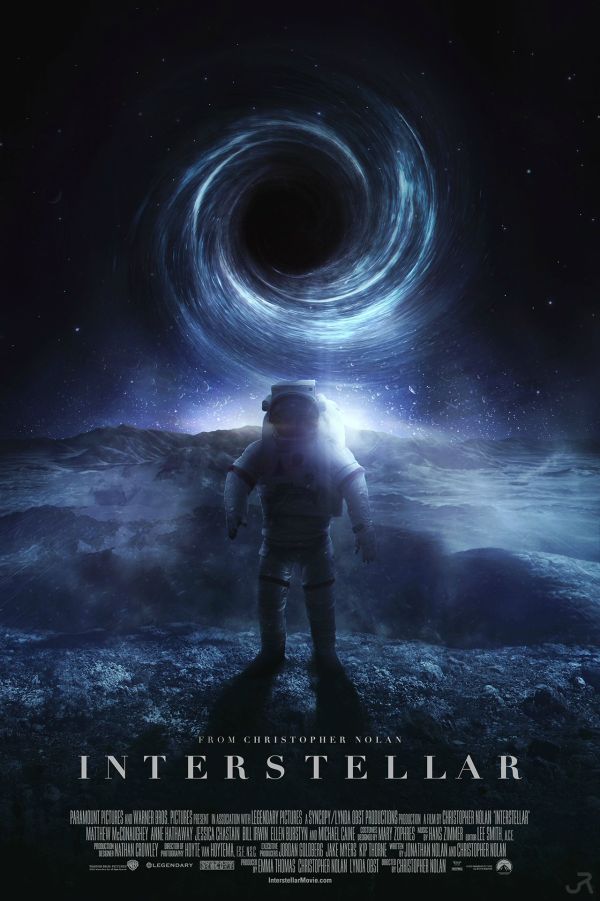INTERSTELLAR (2014, directed Christopher Nolan, 169 minutes, U.S.)
BY DAN BUSKIRK FILM CRITIC No hyperbole has been spared on the arrival of writer/director Christopher Nolan’s new sci-fi epic Interstellar. Like all of Nolan’s recent films, Interstellar triggers an intimidating sense of immense scale, and once again Nolan has delivered a film whose captivating performances and clever design are offset by hose-blasts of sentimentality, self-important bloat and a disagreeable undercurrent of Ayn Rand-ian self-pity. Plus, wise-cracking robots!
The dystopic near-future America of the film’s opening is certainly thought-provoking. From the vantage point of the Cooper family’s rural farm we see a new dust bowl as, one after another, core crops like wheat and potatoes are going extinct. As farmer Cooper (Matthew McConaughey) watches everything wither and go to dust he can’t help but dream that his fate belongs in the stars. Turns out Coop was not only an astronaut but the best pilot NASA ever had, and his skills are needed again when Cooper and his pre-teen daughter Murph (Mackenzie Foy)) discover a secret NASA base hidden nearby. Good thing too, because the future of humanity depends on Coop flying a mission through a wormhole into a new galaxy where we might find a fresh planet to destroy — er, I mean populate.
In some ways the early scenes on Earth are the film’s most vivid. With our recent history of extreme weather events, a world starving to death is a fear not too deeply buried in our collective psyche. Where Dark Knight Rises fantasized that some Occupy-type group was a violent threat, Interstellar‘s nightmare has a bit of a right-wing twist to it. Cooper is in disgust with a collectivist movement that has emerged to address the environmental catastrophe (which of course is never attributed to global warming). In fact, he imagines them suppressing textbooks that tell of the space program, erasing our country’s triumphs in order to direct our energies to the problems on Earth. When Cooper later hooks up with the secret underground NASA facility, the brass bemoan the fact that the public would never support what they do.
NASA’s seemingly misplaced values and Coop’s yearning skyward looks ultimately to pay off, because the answer is in the stars! In a flash Coop has a monumentally teary farewell with his daughter and is soon suited up and leading a spacecraft of astronauts including a pixie-coiffed Anne Hathaway (who summons memories of a young Liza Minnelli,) a few interchangeable white guys and one space-sick, semi-competent black dude (British actor David Gyasi). In their Apollo-styled spaceship, it is through the wormhole for this crew in a short-cut across time to investigate whether a pioneering mission that launched 10 years prior was able to find sustaining conditions on three nearby planets.
From there the film turns into a flashback to the sort of sci-fi mission films we saw beginning in the 1950s: with a square-jawed straight-shooter barking out military-style commands and sweating about incoming asteroids and whether the air-lock is going to blow and flirting with a cute young thing who is no dummy when it comes to science. With an estimated $165 million budget, Interstellar should visually please those who like watching rockets bump-and-grind in space although with modern CGI of those once blockbuster-exclusive special effects are becoming possible at more modest budgets as well. I was a little surprised that the film’s straight-faced tone included a wise-cracking robot but TARS (voiced by old pro Bill Irwin) is one of the cleverest designs of the film. A big block of steel who scissors around like a folding ruler, TARS makes jokes whose frequency and degree of disconcerting absurdity depends on an adjustable humor setting. There is an emotional vacuum at the center of Interstellar that allows TARS to steal every scene he is in, despite lacking humanoid features — he’s a shoo-in for the “Best Robot” Oscar that’s only a matter of time.
My hopes were dashed for good when two thirds of the way into the film they finally reach one of the pioneers and when they defrost him and remove him from the bag it is…..Matt Damon. Now Matt Damon is a fine actor and his performance here is perfectly professional. But if you send an audience through space and time and across a harsh terrain they don’t want to meet a likable guy next store, you want something, I don’t know, “lively” perhaps? That’s when it sunk in that this film wasn’t going to be a thinking man’s 2001-styled art piece, it was going to be an out-sized but perfectly acceptable astronaut fantasy. Some of it is nice. There’s a beautiful visualization of the mind-bending possibilities of alternate dimensions represented by a smearing light and shifting, semi-transparent floors of quasi- library stacks. There’s also a lot of strenuous crying over missing loved ones and the theory that love is stronger than a black hole, an idea that takes a certain primate grandiosity to propose. But in the end Interstellar reveals itself to be not a sci-fi of ideas but a formulaic and overlong space mission movie — like Armageddon, The Black Hole, Enemy Mine or the like — that doesn’t so much bend time as merely kill it.

